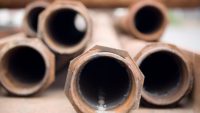Most of us have probably experienced the exercise known as “value engineering,” the process where everyone on the team looks at a design and tries to find ways to save some money.
It can be especially disheartening if you’ve put in long hours to design a system that gets removed from the job. Knowing when a system isn’t required can save money for the owner, as well as extra work and coordination for the design team. One system that can sometimes be removed is the secondary overflow drainage. If you can add up all those raindrops that fall on a roof with clogged drains and they weigh less than the roof can support, you may be able to help lead the owner to that pot of gold at the end of the rainbow.
This is one of those exercises in design when we need to collaborate with others. Plumbing codes don’t typically tell us how to omit a critical building system, so we will likely need to talk to the structural engineer and architect on the job. Plumbing codes will instruct us how to install secondary overflow systems and are understandably conservative with their requirement. The International Plumbing Code’s structural design section requires us to consider “maximum depth of ponding.”
This is where we can be proactive. Pick up the phone and talk to the structural engineer on the job. We can try to talk to the architect about providing scuppers. My experience is that this is rarely acceptable. Before we talk to the structural engineer, it’s a good idea to be prepared with information. How much is all that water going to weigh? This is where our engineering skills come into play, and we can crunch some numbers.
What makes engineering so interesting is performing calculations using different methods and comparing the results. As we all know, the answers never come out the same. That would be too easy. I would like to present two methods below, one a little more creative than the other.
The first method is how I imagine Lucky the leprechaun might protect his mud-thatched roof from ponding and collapsing. First, he would estimate the number of raindrops that would cause the roof to collapse — probably a few-hundred million. He would then calculate how many raindrops are in a grain and then convert to pounds.
As it turns out, there are around 124 raindrops in a grain. Since there are 7,000 grains in a pound of water, he knows it will take around 500 million raindrops to pond on his roof before he needs an emergency overflow system:
500 million raindrops x (1 grain)/(124 raindrops) x
(1 pound)/(7,000 grains)=576 pounds
The second method, and the one we should be familiar with, is to calculate our volume of ponding on a roof and convert to weight. This method uses two of the most useful pieces of information in plumbing engineering:
1 cubic foot can hold 7.48 gallons of water
1 gallon of water weighs 8.33 pounds
I like to think of ways to help me remember these handy conversions. When it comes to how many gallons in cubic feet, I imagine the gas tank for my car. It usually takes around 15 gallons to fill it up, and I figure the tank is around 2 cubic feet; that’s the space you make between your hands when you go to welcome an old friend. For the weight of a gallon, I just picture myself grabbing a 1 gallon jug at the market. It feels like around 8 pounds or so.
The volume held by a roof with a parapet will be the area of the roof multiplied by the height of the parapet. For an average supermarket, like the one I got that jug of water from, the area is around 40,000 square feet. If that building has a 3-foot parapet, the weight of ponded water would be:
120,000 ft^3 x 8.33 pounds/(ft^3 )=999,600 pounds of water
This calculation is somewhat simplistic, but it shows the tools we can use to communicate with structural engineers, architects and building officials. It can also help us answer an owner when they ask questions such as, “Why do we need all that extra piping?” or have a doubletake when they realize they need overflow downspouts noticeably placed on their new glass and stainless-trim façade.
Ultimately, we provide designs that are code compliant, and that is what is important for public safety. By using our engineering skills, we can work with a project team to bring things into budget. By looking at things from a different angle, just as light is refracted in the raindrops of Lucky’s rainbow, we can build on our skills and help find that pot of gold.





